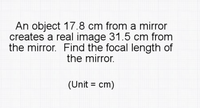
College Physics
11th Edition
ISBN: 9781305952300
Author: Raymond A. Serway, Chris Vuille
Publisher: Cengage Learning
expand_more
expand_more
format_list_bulleted
Concept explainers
Question

Transcribed Image Text:An object 17.8 cm from a mirror
creates a real image 31.5 cm from
the mirror. Find the focal length of
the mirror.
(Unit = cm)
Expert Solution
This question has been solved!
Explore an expertly crafted, step-by-step solution for a thorough understanding of key concepts.
This is a popular solution
Trending nowThis is a popular solution!
Step by stepSolved in 2 steps with 2 images

Knowledge Booster
Learn more about
Need a deep-dive on the concept behind this application? Look no further. Learn more about this topic, physics and related others by exploring similar questions and additional content below.Similar questions
- A mirror produces an image that is located 28.0 cm behind the mirror, when the object is located 7.90cm in front of the mirro. What is the focal length of the mirror? Is the mirror concave or convex?arrow_forwardA dentist uses a mirror to examine a tooth that is 1.00 cm in front of the mirror. The image of the tooth is formed 13.0 cm behind the mirror. (a) Determine the mirror's radius of curvature. cm (b) Determine the magnification of the image.arrow_forwardA man standing 1.58 m in front of a shaving mirror produces an inverted image 19.6 cm in front of it. How close to the mirror should he stand if he wants to form an upright image of his chin that is twice the chin's actual size? cmarrow_forward
- A dentist uses a spherical mirror to examine a tooth. The tooth is 1.14 cm in front of the mirror, and the image is formed 12.0 cm behind the mirror. Determine the mirror's radius of curvature. Determine the magnification of the image.arrow_forwardA concave mirror has a radius of curvature of 35.0 cm. What is its focal length? A ladybug 7.70 mm tall is located 22.6 cm from this mirror along the principal axis. Find the location of the image of the insect. Find the height of the image of the insect.arrow_forwardA mirror produces an image that is located 47.0 cm behind the mirror, when the object is located 6.40 cm in front of the mirror. (a) What is the focal length of the mirror? (b) Is the mirror concave or convex?arrow_forward
- When an object is placed 40.5 cm in front of a convex spherical mirror, a virtual image forms 13.5 cm behind the mirror. Determine the mirror's focal length in cm and the magnification. HINT (a) the mirror's focal length in cm cm (b) the magnificationarrow_forwardA 2.25-cm-high object is placed 4.00 cm in front of a concave mirror. If the image is 6.00 cm high and virtual, what is the focal length of the mirror? cmarrow_forwardWhen an object is placed 38.5 cm in front of a convex spherical mirror, a virtual image forms 12.5 cm behind the mirror. Determine the mirror's focal length in cm and the magnification. HINTarrow_forward
- A small convex mirror and a large concave mirror are separated by 1 m, and an object is placed 1.4 m to the left of the concave mirror. The concave mirror forms an image of this object 25 cm in front of it. This image is then reflected in the convex mirror, which forms an image at a distance 8 cm behind it. What is the focal length of the convex mirror?arrow_forwardAn object is placed 44.0 cm from a concave spherical mirror with focal length of magnitude 15.5 cm. (a) Find the location of the image.cm in front of the mirror(b) What is the magnification of the image?(c) Is the image real or virtual? real virtualarrow_forwardA candle is placed 14.0 cm in front of a convex mirror. When the convex mirror is replaced with a plane mirror, the image moves 8.00 cm farther away from the mirror. Find the focal length of the convex mirror.arrow_forward
arrow_back_ios
SEE MORE QUESTIONS
arrow_forward_ios
Recommended textbooks for you
 College PhysicsPhysicsISBN:9781305952300Author:Raymond A. Serway, Chris VuillePublisher:Cengage Learning
College PhysicsPhysicsISBN:9781305952300Author:Raymond A. Serway, Chris VuillePublisher:Cengage Learning University Physics (14th Edition)PhysicsISBN:9780133969290Author:Hugh D. Young, Roger A. FreedmanPublisher:PEARSON
University Physics (14th Edition)PhysicsISBN:9780133969290Author:Hugh D. Young, Roger A. FreedmanPublisher:PEARSON Introduction To Quantum MechanicsPhysicsISBN:9781107189638Author:Griffiths, David J., Schroeter, Darrell F.Publisher:Cambridge University Press
Introduction To Quantum MechanicsPhysicsISBN:9781107189638Author:Griffiths, David J., Schroeter, Darrell F.Publisher:Cambridge University Press Physics for Scientists and EngineersPhysicsISBN:9781337553278Author:Raymond A. Serway, John W. JewettPublisher:Cengage Learning
Physics for Scientists and EngineersPhysicsISBN:9781337553278Author:Raymond A. Serway, John W. JewettPublisher:Cengage Learning Lecture- Tutorials for Introductory AstronomyPhysicsISBN:9780321820464Author:Edward E. Prather, Tim P. Slater, Jeff P. Adams, Gina BrissendenPublisher:Addison-Wesley
Lecture- Tutorials for Introductory AstronomyPhysicsISBN:9780321820464Author:Edward E. Prather, Tim P. Slater, Jeff P. Adams, Gina BrissendenPublisher:Addison-Wesley College Physics: A Strategic Approach (4th Editio...PhysicsISBN:9780134609034Author:Randall D. Knight (Professor Emeritus), Brian Jones, Stuart FieldPublisher:PEARSON
College Physics: A Strategic Approach (4th Editio...PhysicsISBN:9780134609034Author:Randall D. Knight (Professor Emeritus), Brian Jones, Stuart FieldPublisher:PEARSON

College Physics
Physics
ISBN:9781305952300
Author:Raymond A. Serway, Chris Vuille
Publisher:Cengage Learning

University Physics (14th Edition)
Physics
ISBN:9780133969290
Author:Hugh D. Young, Roger A. Freedman
Publisher:PEARSON

Introduction To Quantum Mechanics
Physics
ISBN:9781107189638
Author:Griffiths, David J., Schroeter, Darrell F.
Publisher:Cambridge University Press

Physics for Scientists and Engineers
Physics
ISBN:9781337553278
Author:Raymond A. Serway, John W. Jewett
Publisher:Cengage Learning

Lecture- Tutorials for Introductory Astronomy
Physics
ISBN:9780321820464
Author:Edward E. Prather, Tim P. Slater, Jeff P. Adams, Gina Brissenden
Publisher:Addison-Wesley

College Physics: A Strategic Approach (4th Editio...
Physics
ISBN:9780134609034
Author:Randall D. Knight (Professor Emeritus), Brian Jones, Stuart Field
Publisher:PEARSON